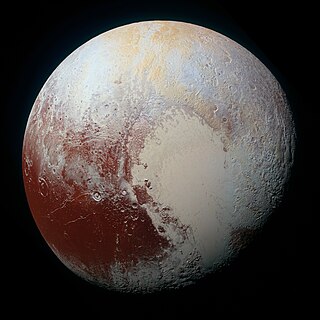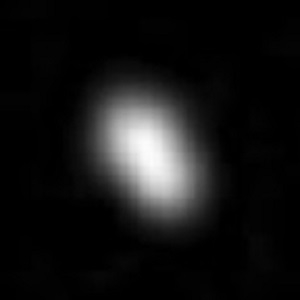
Pluto is a dwarf planet in the Kuiper belt, a ring of bodies beyond the orbit of Neptune. It is the ninth-largest and tenth-most-massive known object to directly orbit the Sun. It is the largest known trans-Neptunian object by volume, by a small margin, but is less massive than Eris. Like other Kuiper belt objects, Pluto is made primarily of ice and rock and is much smaller than the inner planets. Pluto has roughly one-sixth the mass of Earth's moon, and one-third its volume.

Charon, known as (134340) Pluto I, is the largest of the five known natural satellites of the dwarf planet Pluto. It has a mean radius of 606 km (377 mi). Charon is the sixth-largest known trans-Neptunian object after Pluto, Eris, Haumea, Makemake, and Gonggong. It was discovered in 1978 at the United States Naval Observatory in Washington, D.C., using photographic plates taken at the United States Naval Observatory Flagstaff Station (NOFS).

Marc William Buie is an American astronomer and prolific discoverer of minor planets who works at the Southwest Research Institute in Boulder, Colorado in the Space Science Department. Formerly he worked at the Lowell Observatory in Flagstaff, Arizona, and was the Sentinel Space Telescope Mission Scientist for the B612 Foundation, which is dedicated to protecting Earth from asteroid impact events.

The geology of Pluto consists of the characteristics of the surface, crust, and interior of Pluto. Because of Pluto's distance from Earth, in-depth study from Earth is difficult. Many details about Pluto remained unknown until 14 July 2015, when New Horizons flew through the Pluto system and began transmitting data back to Earth. When it did, Pluto was found to have remarkable geologic diversity, with New Horizons team member Jeff Moore saying that it "is every bit as complex as that of Mars". The final New Horizons Pluto data transmission was received on 25 October 2016. In June 2020, astronomers reported evidence that Pluto may have had a subsurface ocean, and consequently may have been habitable, when it was first formed.

Nix is a natural satellite of Pluto, with a diameter of 49.8 km (30.9 mi) across its longest dimension. It was discovered along with Pluto's outermost moon Hydra on 15 May 2005 by astronomers using the Hubble Space Telescope, and was named after Nyx, the Greek goddess of the night. Nix is the third moon of Pluto by distance, orbiting between the moons Styx and Kerberos.

Hydra is a natural satellite of Pluto, with a diameter of approximately 51 km (32 mi) across its longest dimension. It is the second-largest moon of Pluto, being slightly larger than Nix. Hydra was discovered along with Nix by astronomers using the Hubble Space Telescope on 15 May 2005, and was named after the Hydra, the nine-headed underworld serpent in Greek mythology. By distance, Hydra is the fifth and outermost moon of Pluto, orbiting beyond Pluto's fourth moon Kerberos.

The dwarf planet Pluto has five natural satellites. In order of distance from Pluto, they are Charon, Styx, Nix, Kerberos, and Hydra. Charon, the largest, is mutually tidally locked with Pluto, and is massive enough that Pluto and Charon are sometimes considered a binary dwarf planet.

A dwarf planet is a small planetary-mass object that is in direct orbit around the Sun, massive enough to be gravitationally rounded, but insufficient to achieve orbital dominance like the eight classical planets of the Solar System. The prototypical dwarf planet is Pluto, which for decades was regarded as a planet before the "dwarf" concept was adopted in 2006.

The exploration of Pluto began with the arrival of the New Horizons probe in July 2015, though proposals for such a mission had been studied for many decades. There are no plans as yet for a follow-up mission, though follow-up concepts have been studied.

Kerberos is a small natural satellite of Pluto, about 19 km (12 mi) in its longest dimension. Kerberos is also the second-smallest moon of Pluto, after Styx. It was the fourth moon of Pluto to be discovered and its existence was announced on 20 July 2011. It was imaged, along with Pluto and its four other moons, by the New Horizons spacecraft in July 2015. The first image of Kerberos from the flyby was released to the public on 22 October 2015.

Styx is a small natural satellite of Pluto whose discovery was announced on 11 July 2012. It was discovered by use of the Hubble Space Telescope, and is the smallest of the five known moons of Pluto. It was imaged along with Pluto and Pluto's other moons by the New Horizons spacecraft in July 2015, albeit poorly with only a single image of Styx obtained.

Belton Regio is a prominent surface feature of the dwarf planet Pluto. It is an elongated dark region along Pluto's equator, 2,990 km (1,860 mi) long and one of the darkest features on its surface.

The geology of Charon encompasses the characteristics of the surface, crust, and interior of Pluto's moon Charon. Like the geology of Pluto, almost nothing was known of Charon's geology until the New Horizons of the Pluto system on 14 July 2015. Charon's diameter is 1,208 km (751 mi)—just over half that of Pluto. Charon is sufficiently massive to have collapsed into a spheroid under its own gravity.

The geography of Pluto refers to the study and mapping of physical features across the dwarf planet Pluto. On 14 July 2015, the New Horizons spacecraft became the first spacecraft to fly by Pluto. During its brief flyby, New Horizons made detailed geographical measurements and observations of Pluto and its moons.

Vulcan Planitia, or Vulcan Planum, is the unofficial name given to a large plain on the southern hemisphere of Pluto's moon Charon. It discovered by New Horizons during its flyby of Pluto in July 2015. It is named after the fictional planet Vulcan in the science-fiction series Star Trek. The name is not approved by International Astronomical Union (IAU) as of 2024.

Vader is the unofficial name given to a dark crater on Pluto's largest moon Charon. The floor of Vader is darker than the surrounding terrain, covered in the same reddish-brown dark material that covers Mordor Macula on Charon's north pole. Though Charon's surface trends darker with increasing latitude, some craters, such as Vader, interrupt this trend. The crater was discovered by NASA's New Horizons space probe on its way by Pluto. It is named after the character Darth Vader from the Star Wars media franchise; the name has yet to be officially approved by the International Astronomical Union (IAU).

Nasreddin is a crater on Pluto's largest moon, Charon. The crater was first observed by NASA's New Horizons space probe on its flyby of Pluto in 2015. The name was chosen as a reference to Nasreddin, the hero of humorous folktales told throughout the Middle East, Southern Europe, and parts of Asia. The name was officially approved by the International Astronomical Union (IAU) on 11 April 2018.


















